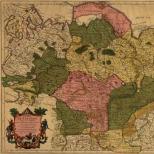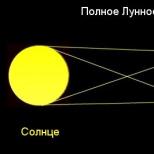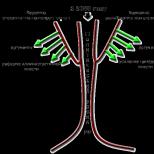A planet that rotates counterclockwise. Which planet rotates in the opposite direction. Venus has no natural satellites
Venus is the second planet solar system. Its neighbors are Mercury and Earth. The planet was named after the Roman goddess of love and beauty - Venus. However, it soon turned out that the surface of the planet had nothing to do with the beautiful.
Knowledge about this celestial body was very scarce until the middle of the 20th century due to dense clouds hiding Venus from the view of telescopes. However, with the development of technical capabilities, mankind has learned many new and interesting facts about this amazing planet. Many of them raised a number of questions that are still unanswered.
Today we will discuss the hypotheses that explain why Venus rotates counterclockwise, and we will tell interesting facts about it, known to planetology today.
What do we know about Venus?

In the 60s, scientists still had a glimmer of hope that the conditions for living organisms. These hopes and ideas were embodied in their works by science fiction writers who described the planet as a tropical paradise.
However, after the spacecraft were sent to the planet, which provided the first idea about the scientists, they came to disappointing conclusions.
Venus is not only uninhabitable, it has a very corrosive atmosphere that destroyed several of the first spacecraft sent into its orbit. But despite the fact that the connection with them was lost, the researchers still managed to get an idea about chemical composition atmosphere of the planet and its surface.
Also, researchers were interested in the question of why Venus rotates counterclockwise, just like Uranus.
twin planet
Today it is known that Venus and the Earth are very similar in physical characteristics. Both of them belong to the terrestrial group of planets, like Mars and Mercury. These four planets have few or no satellites, have a weak magnetic field and devoid of a ring system.
Venus and the Earth have a similar mass and are only slightly inferior to our Earth), and also rotate in similar orbits. However, this is where the similarity ends. The rest of the planet is in no way similar to Earth.
The atmosphere on Venus is very aggressive and consists of carbon dioxide by 95%. The temperature of the planet is absolutely unsuitable for life, as it reaches 475 ° C. In addition, the planet has very high pressure (92 times higher than on Earth), which will crush a person if he suddenly decides to walk on its surface. Destroy all living things and clouds of sulfur dioxide, creating precipitation from sulfuric acid. The layer of these clouds reaches 20 km. Despite its poetic name, the planet is a hellish place.
What is the rotational speed of Venus on its axis? As it turned out as a result of research, one Venusian day is equal to 243 Earth days. The planet rotates at a speed of only 6.5 km / h (for comparison, the rotation speed of our Earth is 1670 km / h). At the same time, one Venusian year is 224 Earth days.
Why does Venus rotate counterclockwise?

This question has been troubling scientists for more than a decade. However, no one has been able to answer it so far. There have been many hypotheses, but none of them has yet been confirmed. Nevertheless, we will consider some of the most popular and interesting ones.
The fact is that if you look at the planets of the solar system from above, Venus rotates counterclockwise, while all other celestial bodies (except Uranus) rotate clockwise. These include not only planets, but also asteroids and comets.
When viewed from the north pole, Uranus and Venus rotate clockwise, and all other celestial bodies - against it.
Reasons why Venus rotates counterclockwise

However, what caused this deviation from the norm? Why does Venus rotate counterclockwise? There are several popular hypotheses.
- Once upon a time, at the dawn of the formation of our solar system, there were no planets around the Sun. There was only one disk of gas and dust, which rotated clockwise, which over time was transferred to other planets. A similar rotation was observed for Venus. However, soon the planet likely collided with a huge body that crashed into it against its rotation. Thus, the space object seemed to "launch" the movement of Venus in the opposite direction. Maybe Mercury is to blame. This is one of the most interesting theories that explains several amazing facts at once. Mercury was once a satellite of Venus. However, later he collided with her on a tangent, giving Venus part of his mass. He himself flew into a lower orbit around the Sun. That is why its orbit has a curved line, and Venus rotates in the opposite direction.
- Venus can be rotated by the atmosphere. The width of its layer reaches 20 km. Moreover, its mass is slightly less than the earth. The density of the atmosphere of Venus is very high and literally squeezes the planet. Perhaps it is the dense atmosphere that rotates the planet in a different direction, which explains why it rotates so slowly - only 6.5 km / h.
- Other scientists, observing how Venus rotates around its axis, have come to the conclusion that the planet is turned upside down. It continues to move in the same direction as the other planets, however, due to its position, it rotates in the opposite direction. Scientists believe that this phenomenon could be caused by the influence of the Sun, which caused strong gravitational tides, combined with friction between the mantle and the core of Venus itself.
Conclusion
Venus is a terrestrial planet, unique in nature. The reason why it rotates in the opposite direction is still a mystery to mankind. Maybe someday we'll figure it out. In the meantime, we can only build assumptions and hypotheses.
Planet Venus interesting facts. Some you may already know, others should be completely new to you. So read and learn new interesting facts about the "morning star".

Earth and Venus are very similar in size and mass, and they orbit the Sun in very similar orbits. Its size is only 650 km smaller than the size of the Earth, and the mass is 81.5% of the mass of the Earth.
But that's where the similarity ends. The atmosphere is made up of 96.5% carbon dioxide, and the greenhouse effect raises the temperature to 461°C.
2. A planet can be so bright that it casts shadows.
Only the Sun and Moon are brighter than Venus. Its brightness can vary from -3.8 to -4.6 magnitudes, but it is always brighter than the brightest stars in the sky.
3. Hostile atmosphere

The mass of the atmosphere is 93 times greater than the Earth's atmosphere. The pressure on the surface is 92 times greater than the pressure on Earth. It is also like diving a kilometer under the surface of the ocean.
4. It rotates in the opposite direction compared to other planets.
Venus rotates very slowly, a day is 243 Earth days. Even stranger is that it rotates in the opposite direction compared to all other planets in the solar system. All planets rotate in a counter-clockwise direction. Except for the heroine of our article. It rotates clockwise.
5. Many spacecraft have managed to land on its surface.

In the midst of the space race Soviet Union launched a series of Venus spacecraft and some have successfully landed on its surface.
Venera 8 was the first spacecraft to land on the surface and transmit photographs to Earth.
6. People used to think that there are "tropics" on the second planet from the Sun.

While we sent the first spacecraft to study Venus at close range, no one really knew what was hidden below under the dense clouds of the planet. Science fiction writers dreamed of lush tropical jungles. The hellish temperature and dense atmosphere surprised everyone.
7. The planet has no satellites.
Venus looks like our twin. Unlike Earth, it has no moons. Mars has moons, and even Pluto has moons. But she... no.
8. The planet has phases.

Although it looks like a very bright star in the sky, if you can look at it with a telescope, you will see something different. When looking at it through a telescope, you can see that the planet goes through phases like the moon. When it is closer, it looks like a thin crescent. And at the maximum distance from the Earth, it becomes dim and in the form of a circle.
9. There are very few craters on its surface.

While the surfaces of Mercury, Mars, and the Moon are littered with impact craters, there are relatively few craters on the surface of Venus. Planetary scientists believe that its surface is only 500 million years old. Constant volcanic activity smoothes and removes any impact craters.
10. The last ship to explore Venus is the Venus Express.

I became interested in the topic of what rotates clockwise and what against. Very often you can find a lot of things in the world based on vortexes, spirals, twists, having a right spin of rotation, that is, twisted according to the gimlet rule, the right hand rule, and the left spin of rotation.
Spin is the intrinsic angular momentum of a particle. In order not to complicate the note with theory, it is better to see once. The element of the slow waltz is the right spin turn.
For many years there has been a discussion among astronomers about the direction in which spiral galaxies rotate. Do they rotate, dragging spiral branches behind them, i.e., twisting? Or do they rotate the ends of the spiral branches forward, unwinding?
At present, however, it is becoming clear that observations confirm the hypothesis of TWISTING of the spiral arms as they rotate. American physicist Michael Longo was able to confirm that most of galaxies in the Universe is oriented to the right side (right spin rotation) i.e. rotates clockwise when viewed from its north pole.
The rotation of the solar system is counterclockwise: all planets, asteroids, comets rotate in the same direction (counterclockwise, when viewed from the north pole of the world). The sun rotates on its axis counterclockwise when viewed from the north ecliptic pole. And the Earth (like all the planets of the solar system, except for Venus and Uranus) rotates counterclockwise around its axis.
The mass of Uranus, sandwiched between the mass of Saturn and the mass of Neptune, under the influence of the rotational moment of the mass of Saturn, received a clockwise rotation. Such an impact from Saturn could occur for the reason that the mass of Saturn is 5.5 times the mass of Neptune.
Venus rotates in the opposite direction than almost all planets. The mass of the planet Earth spun the mass of the planet Venus, which received a clockwise rotation. Therefore, the daily periods of rotation of the planets of the Earth and Venus should also be close to each other.
What else is spinning and spinning?
The snail's house spins clockwise from the center (i.e., the rotation here is with a left spin turn, counterclockwise).

Tornadoes, hurricanes (winds centered in the cyclone area) blow counterclockwise in the Northern Hemisphere and are subject to centripetal force, while winds centered in the anticyclone area blow clockwise and have centrifugal force. (In the Southern Hemisphere, it's exactly the opposite.)

The DNA molecule is twisted into a right-handed double helix. This is because the backbone double helix DNA is composed exclusively of right-handed deoxyribose sugar molecules. Interestingly, when cloning, some nucleic acids change the direction of twist of their spirals from right to left. On the contrary, all amino acids are twisted counterclockwise, to the left.
Flocks of bats, flying out of the caves, usually form a "right-handed" vortex. But in the caves near Karlovy Vary (Czech Republic), for some reason they circle in a counterclockwise spiral...
In one cat, at the sight of sparrows (these are her favorite birds), the tail rotates clockwise, and if these are not sparrows, but other birds, then it rotates counterclockwise.
And if we take Humanity, then we see that all sporting events (car races, horse races, running at the stadium, etc.) pass counterclockwise. After some centuries, athletes noticed that it is much more convenient to run this way. Running the stadium counterclockwise, the athlete takes a wider step with his right foot than he would have taken with his left, since the range of motion of the right leg is several centimeters larger. In most armies of the countries of the world, the turn around is carried out through the left shoulder, that is, counterclockwise; church rituals; the movement of cars on the roads in most countries of the world, with the exception of the UK, Japan and some others; at school, the letters "o", "a", "c", etc. - from the first grade they are taught to write counterclockwise. In the future, the vast majority of the adult population draws a circle, stirs the sugar in the mug with a spoon counterclockwise.
And what follows from all this? Question: Is it natural for a person to rotate counterclockwise?
As a conclusion: the Universe moves clockwise, but the solar system is against it, the physical development of all living things is clockwise, consciousness is against it.
We have been studying the solar system for hundreds of years, and one would assume that we have the answers to all the frequently asked questions about it. Why the planets rotate, why they are in such orbits, why the Moon does not fall to the Earth… But we cannot boast of this. To see this, just look at our neighbor, Venus.
Scientists began to study it closely in the middle of the last century, and at first it seemed relatively dull and of little interest. However, it soon became clear that this is the most natural hell with acid rain, which also rotates in the opposite direction! More than half a century has passed since then. We've learned a lot about Venus's climate, but we still haven't been able to figure out why it doesn't spin like everyone else. Although there are many hypotheses in this regard.
In astronomy, rotation in the opposite direction is called retrograde. Since the entire solar system was formed from a single rotating gas cloud, all the planets orbit in the same direction - counterclockwise, if you look at this whole picture from above, from the north pole of the Earth. In addition, these celestial bodies also rotate around their own axis - also counterclockwise. But this does not apply to the two planets of our system - Venus and Uranus.
Uranus is actually lying on its side, most likely due to a couple of collisions with large objects. Venus, on the other hand, rotates clockwise, and explaining this is even more problematic. One of the early hypotheses suggested that Venus collided with an asteroid, and the impact was so strong that the planet began to spin in the opposite direction. This theory was thrown into the discussion of the interested public in 1965 by two astronomers who processed radar data. Moreover, the definition of “thrown in” is by no means a humiliation. As the scientists themselves stated, the quote: “This possibility is dictated only by the imagination. It is hardly possible to obtain evidence confirming it.” Extremely convincing, isn't it? Be that as it may, this hypothesis does not stand up to the test of simple mathematics - it turns out that an object whose size is sufficient to reverse the rotation of Venus will simply destroy the planet. Its kinetic energy will be 10,000 times more than what it takes to smash the planet to dust. In this regard, the hypothesis was sent to the distant shelves of scientific libraries.
It was replaced by several theories based on some evidence base. One of the most popular, proposed in 1970, suggested that Venus originally rotated in this way. It just turned upside down at some point in its history! This could be due to the processes that took place inside Venus and in its atmosphere.

This planet, like the Earth, is multi-layered. Here, too, there is a core, mantle and crust. During the rotation of the planet, the core and mantle experience friction in the area of their contact. The atmosphere of Venus is very thick, and, thanks to the heat and attraction of the Sun, it is subjected, like the rest of the planet, to the tidal influence of our luminary. According to the described hypothesis, the friction of the crust with the mantle, coupled with atmospheric tidal oscillations, created a torque, and Venus, having lost stability, capsized. The simulations performed showed that this could only happen if Venus had an axial tilt of about 90 degrees since its formation. Later this number decreased somewhat. In any case, this is a highly unusual hypothesis. Just imagine - a tumbling planet! This is some kind of circus, not space.

In 1964, a hypothesis was put forward, according to which Venus changed its rotation gradually - it slowed down, stopped, and began to spin in the other direction. This could be triggered by several factors, including interactions with the Sun's magnetic field, atmospheric tides, or a combination of several forces. The atmosphere of Venus, according to this theory, spun in the opposite direction of the first. This created a force that first slowed Venus and then spun it retrograde. As a bonus, this hypothesis also explains the long duration of the day on the planet.

In the dispute between the last two explanations, there is no clear favorite yet. To understand which one to prefer, we need to know much more about the dynamics of early Venus, in particular about its rotation rate and axial tilt. According to an article published in 2001 in the journal Nature, Venus is more likely to tip over if it has a higher initial rotational speed. But, if it was less than one revolution in 96 hours with a slight axial tilt (less than 70 degrees), the second hypothesis looks more plausible. Unfortunately, it is quite difficult for scientists to look into the past four billion years. Therefore, until we invent a time machine or run unrealistically high-quality computer simulations today, progress in this matter is not expected.

It is clear that this is not Full description discussions concerning the rotation of Venus. So, for example, the very first of the hypotheses we described, the one that comes from 1965, received an unexpected development not so long ago. In 2008, it was suggested that our neighbor could spin in the opposite direction at a time when she was still a small unintelligent planetesimal. An object about the same size as Venus itself should have crashed into it. Instead of the destruction of Venus, the merging of two celestial bodies into one full-fledged planet would follow. The main difference from the original hypothesis here is that scientists may have evidence in favor of this turn of the situation.

Based on what we know about the topography of Venus, there is very little water on it. Compared to Earth, of course. Moisture could disappear from there as a result of a catastrophic collision of cosmic bodies. That is, this hypothesis would also explain the dryness of Venus. Although there are also, no matter how ironic it may sound in this case, pitfalls. Water from the surface of the planet could simply evaporate under the rays of the Sun, which is hot here. To clarify this issue, a mineralogical analysis of rocks from the surface of Venus is needed. If water is present in them, the hypothesis of an early collision will disappear. The problem is that such analyzes have not yet been carried out. Venus is extremely unfriendly to the robots that we send to her. Destroys without any hesitation.
Be that as it may, building an interplanetary station with a rover capable of working here is still easier than a time machine. So let's not lose hope. Perhaps humanity will receive an answer to the riddle about the "wrong" rotation of Venus even during our lifetime.
I became interested in the topic of what rotates clockwise and counterclockwise, and that's what I found.
The galaxy is spinning By clockwise when viewed from its north pole, located in the constellation Coma Berenices.
The rotation of the solar system is against clockwise: all planets, asteroids, comets rotate in the same direction (counterclockwise when viewed from the north celestial pole).
The sun rotates on its axis against the movement of the hour hand as viewed from the north ecliptic pole. And the Earth (like all the planets of the solar system, except Venus) rotates around its axis against hour hand.
Perhaps it is this rotation of the Galaxy (clockwise) and the Solar System (counterclockwise) that is displayed on the eight-pointed swastika kolovrat (right rays), inside which there is another eight-pointed swastika kolovrat (left rays). link
An interesting experience was observed by travelers crossing the equator. If you throw a match or a twig into a funnel filled with water, then in the Southern Hemisphere it spins clockwise, in the Northern against it, and stands at the equator. link
According to the law of right-hand traffic, adopted in our country, the roundabout goes counterclockwise. With the oncoming movement of two cars racing at high speeds, an air vortex rotating counterclockwise arises. And when there are a huge number of such meeting pairs, these vortices can cause a tornado. link
Helicopter rotors in different countries spin in different directions. That is, in some countries, helicopters are made with a propeller rotating clockwise, and in others - against. If you look at the helicopter from above, then:
in America, Germany and Italy, the screw turns counterclockwise.
in Russia and France clockwise. link
Flocks of bats, flying out of the caves, usually form a "right-handed" vortex. But in the caves near Karlovy Vary (Czech Republic), for some reason they circle in a counterclockwise spiral... link
In one cat, at the sight of sparrows (these are her favorite birds), the tail rotates clockwise, and if these are not sparrows, but other birds, then it rotates counterclockwise. link
But the dog, before going on business, will definitely spin counterclockwise. link
The spiral staircases in the castles were twisted clockwise (when viewed from below, and if viewed from above, then counterclockwise) so that when climbing it was inconvenient for attackers to attack. link
The DNA molecule is twisted into a right-handed double helix. This is because the backbone of the DNA double helix is made up entirely of right-handed deoxyribose sugar molecules. Interestingly, during cloning, some nucleic acids change the direction of twist of their helices from right to left. On the contrary, all amino acids are twisted counterclockwise, to the left.
The DNA helix is also in space: on milky way scientists have discovered a nebula in the form of a DNA double helix. link
But the spirals of electric light bulbs manufactured in Russia are twisted to the left (unlike foreign ones, which are twisted in the same way as the DNA helix, to the right). The question arises: is it harmful?





